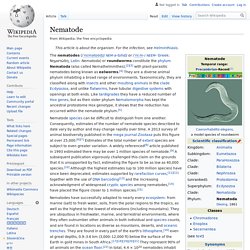

David Attenborough's Great Barrier Reef. Prion. Pathogenic type of misfolded protein Medical condition Prions are misfolded proteins with the ability to transmit their misfolded shape onto normal variants of the same protein.

They characterize several fatal and transmissible neurodegenerative diseases in humans and many other animals.[3] It is not known what causes the normal protein to misfold, but the abnormal three-dimensional structure is suspected of conferring infectious properties, collapsing nearby protein molecules into the same shape. The word prion derives from "proteinaceous infectious particle".[4][5][6] The hypothesized role of a protein as an infectious agent stands in contrast to all other known infectious agents such as viroids, viruses, bacteria, fungi, and parasites, all of which contain nucleic acids (DNA, RNA, or both).
Etymology and pronunciation[edit] Prion protein[edit] Structure[edit] The protein that prions are made of (PrP) is found throughout the body, even in healthy people and animals. Nematode. Phylum of worms with tubular digestive systems with openings at both ends The nematodes ( NEM-ə-tohdz or NEEM- Greek: Νηματώδη; Latin: Nematoda) or roundworms constitute the phylum Nematoda (also called Nemathelminthes),[2][3] with plant-parasitic nematodes being known as eelworms.[4] They are a diverse animal phylum inhabiting a broad range of environments.

Taxonomically, they are classified along with insects and other moulting animals in the clade Ecdysozoa, and unlike flatworms, have tubular digestive systems with openings at both ends. Like tardigrades they have a reduced number of Hox genes, but as their sister phylum Nematomorpha has kept the ancestral protostome Hox genotype, it shows that the reduction has occurred within the nematode phylum.[5] Nathan Cobb, a nematologist, described the ubiquity of nematodes on Earth as thus: The term is from Greek νηματώδης (plural νηματώδεις), ntr. νηματῶδες (plural νηματώδη);[29] Latin: Nematoda.
Etymology[edit] Taxonomy and systematics[edit] The 25 Biggest Turning Points in Earth's History. African Running Phenomenon. Outdoor group fitness classes utilise the Evolve program The African running phenomenon seems to be a topic of much debate.

We have even discussed the topic on this site by looking at genetic factors influencing various athletic achievements. Before we go on I will provide my conclusion on the topic of genetic and racial factors that seem to have a bearing on performance. I will keep it brief. First of all genetics and race clearly play a role in athletic achievement. Why is it that northern Africans dominate middle distance running? This evidence has led my scientific, inquiring mind to certain conclusions. The African running phenomenon appears to have developed out of sheer simplicity and accessibility. Next we have the training methods. Finally we can see that genetics does play a role in the African running phenomenon but not as much as previously thought.
Unleashed.training.fitness@gmail.com Non-Genetic Influence on the African Running Phenomenon Source: Wikipedia. Super Saturnian Storm. Biological immortality. Turritopsis nutricula. Turritopsis nutricula is a small jellyfish.

Several different species of the genus Turritopsis were formerly classified as T. nutricula, including the "immortal jellyfish" which is now classified as T. dohrnii.[2] References[edit] External links[edit] Media related to Turritopsis at Wikimedia Commons Data related to Turritopsis nutricula at Wikispecies. Biology’s Big Bang Had A Long Fuse.